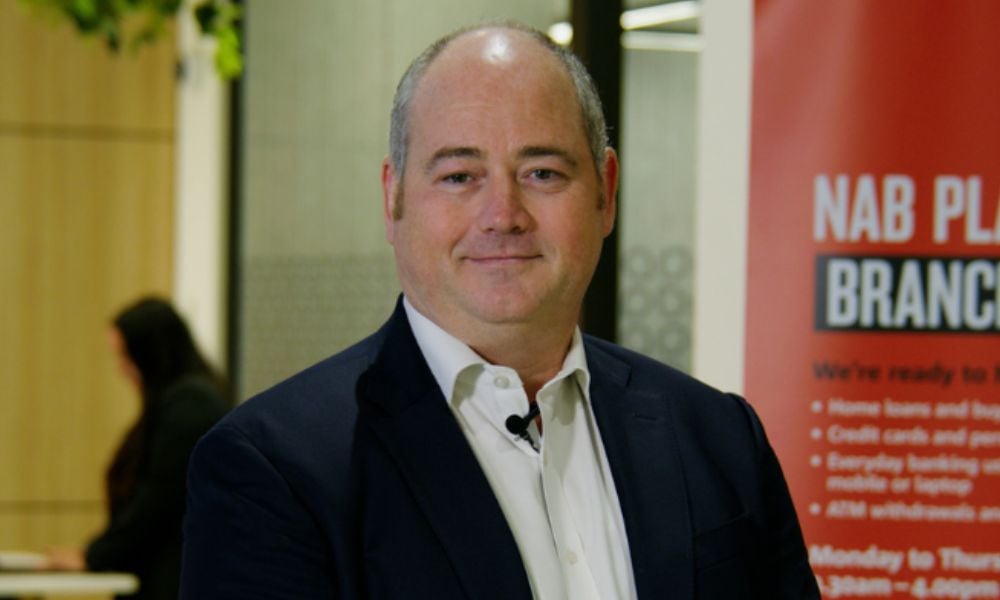"Non-bank lenders are truly demonstrating their value"

NAB, the self-professed largest business bank in Australia, was in the news this week, albeit for not all good reasons.
As reported by the Australian Financial Review, there are rumours of growing discontent over chief executive Andrew Irvine’s management style and, more provocatively, his drinking habits.
While Irvine (pictured, above) has not been accused of any inappropriate behaviour, numerous major shareholders have reportedly raised “serious concerns” about Irvine to the board. In response, the Board has thrown its full support behind Irvine and no disciplinary action has been taken.
Being a citizen of a free country with a robust drinking culture, Irvine’s propensity for an alcoholic beverage feels like a sideshow to the deeper issues at play for NAB.
As suggested by MPA on Wednesday, NAB, as the self-professed largest business bank in Australia, is at the frontlines of a rapidly changing commercial lending market that is welcoming an increasing number of challengers and non-bank lenders to the fray.
More than half of Australia’s SMEs now plan to use non-bank lenders for new investments, up from just 7% in 2014, according to ScotPac’s latest SME Growth Index.
Demand for non-bank financing hit a record 55% in early 2025, rising 7% from last year, as business owners seek faster approvals, flexible criteria, and more funding options. Meanwhile, the share of SMEs turning to traditional banks dropped from 42% to 30%.
What is driving this major shift in the commercial lending landscape? MPA sat down with some of Australia’s leading commercial brokers to find out.
Flexibility is the non-banks’ killer app
“Non-bank lenders are truly demonstrating their value, across the lending landscape, now more than ever – especially for clients who don’t quite fit into the traditional mould that the major banks require,” Danny Alvarez, associate director at award-winning commercial brokerage Simplicity Loans & Advisory, told MPA.
There is “a more open way of looking at a transaction in non-banking space”, added Jon Gawley, managing director and Kanebridge Finance and member of MPA’s Top Commercial Brokers 2025 list.
It’s not for every SME, but Gawley believes that with the right non-bank funder and client mix, “you can really work to tailor transactions, like it was easier with banks some time ago”.
While non-bank lenders tend to offer higher rates, it is a price that SMEs are usually willing to swallow.
“If a client comes to us for cashflow options, they often need funds sooner rather than later, so the speed to settlement can be a high priority,” Darren Sayers (pictured, below), founder and director of Victoria-based brokerage Energy Lend, told MPA.

This sentiment was echoed by Alvarez, who said his clients lead towards flexibility over pricing “nearly every time”.
Broker and patron of Commercial and Asset Finance Brokers Association of Australia (CAFBA) David Gandolfo added: “Since the exodus of smaller non-bank lenders during the GFC (Global Financial Crisis), commercial brokers have been calling for more non-bank lenders to enter the market.
“These lenders are not restrained by banking covenants or stringent lending policies, are less risk averse and offer a broader range of innovative and niche products.”
Brokers, however, also see plenty of natural advantages in working with the majors.
Big banks beating on price
Mainstream lenders like NAB “provide several pathways for a borrower to access funds”, said Sayers. “This provides more options for the client, and an ability to access funding at low rates.”
Major banks, like NAB, “are also helping brokers become total banking solutions for commercial clients”, Sayers added. “We see clear benefits where a client is jointly managed by us as the broker and the business banker”.
Alvarez agreed that the big banks remain a crucial component of the lending landscape.
“The majors like NAB still hold a strong position in the market and for good reason," he said. "They’ve got access to cheaper capital, which usually translates into sharper pricing.”
For clients with up-to-date financials and simpler lending scenarios, “the majors can offer excellent terms, especially on longer-term facilities”, Alvarez said.
They also bring a broader suite of products. “So if a client needs a complete banking relationship – say transactional accounts, working capital, equipment finance and so on, NAB and the other Big Four can deliver that under one roof,” Alvarez said.
Yet Gawley also touched on a mounting problem for the big banks: They’re losing top talent to the broking industry. “A lot of the good bankers are now either brokers or within the non-banking sector. They can assist clients with more ease,” he said.
The big banks are well aware of this brain drain. Commonwealth Bank chief executive Matt Comyn has been vocal about his thoughts on brokers’ lucrative commission structures, which he believes unfairly tilt the scales against banker bonus caps.
While the banking majors still have the trusted brand advantage, Gawley pondered whether the banker brain drain is taking the edge off this advantage.
Non-bank revolution to continue
As mentioned above, the demand for non-bank financing reached new records this year, while the share of SMEs turning to traditional banks dropped.
“This will continue,” Gawley predicted. “They price higher but it is a price for risk. (Clients) are still assessed on merits, but clients are also seeking partnerships which suit their business’ needs.”
“If non-bank lenders continue to expand policy, broaden their product offering and reduce gaps in pricing as compared to major banks, they will continue to grow market share,” Sayers said.
“The shift is already happening,” said Alvarez. “We’re seeing non-banks rapidly gaining market share – particularly in commercial and construction lending."
A lot of this, explained Alvarez, “comes down to access and attitude. Non-banks are more commercially driven, willing to look at the bigger picture, and they often provide solutions that the banks simply can't or just won’t”.

CAFBA chief executive David Bushby (pictured, above) also weighed in, telling MPA: “By virtue of their numbers and broader range of lending products and varying risk profiles, the non-bank lenders have increased in number and will continue to do so. This is not at the expense of major banks, as each offers different types of solutions which often complement each other.”
Brokers have also benefited from the rising influence of non-bank lenders.
Almost all non-bank commercial loans are brokered, since these lenders lack large retail networks. As a result, the number of brokers handling commercial loans jumped over 24% year-on-year as of September 2024, according to the MFAA’s latest Industry Intelligence Service report.
In Sayers’ view, it is the long-term relationships that brokers can forge with their clients that is making them more attractive to SMEs.
“Generally speaking, a broker won’t move on to other roles within the business, and is therefore able to offer a long-term direct relationship with a client," he said.
“The deep understanding that is formed over a long period of time will benefit the client, in that they can more accurately represent the client when talking to existing or potential new lenders.”
But there is a financial benefit too. Brokers can remove overheads related to the sourcing, arranging and managing of their financial arrangement, allowing business owners to focus on what matters – running their businesses.
“A key to our success with SMEs is to meet with them regularly to understand any upcoming finance requirements, and to discuss agreements that are coming up for renewal or maturity,” said Sayers. “It’s much less reactive, which takes a lot of stress away from the client, especially when there are shorter time frames to arrange funding.”
Business owners “don’t have the time or expertise to navigate the credit policies of 20+ lenders, or to structure their application in a way that gets it over the line”, added Alvarez.
“That’s where we come in. A good broker in our space understands the nuances across the bank, non-bank and the private market, but also knows how to position a deal, and has the relationships to get things moving quickly.”



